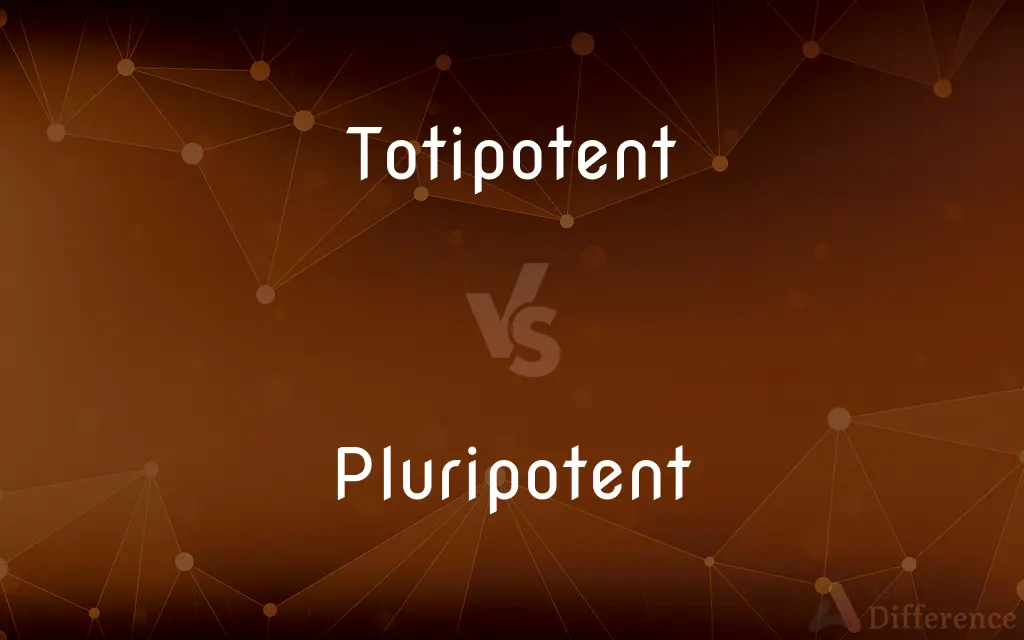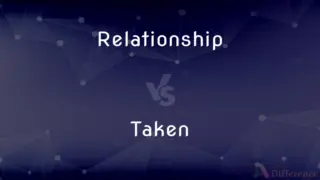Totipotent vs. Pluripotent — What's the Difference?
By Tayyaba Rehman & Maham Liaqat — Updated on March 16, 2024
Totipotent cells have the potential to differentiate into any cell type, including embryonic and extraembryonic tissues, while pluripotent cells can become any cell type within the embryo but not extraembryonic tissues.

Difference Between Totipotent and Pluripotent
Table of Contents
ADVERTISEMENT
Key Differences
Totipotent cells are the most versatile, with the ability to develop into any cell type, including those needed to form the placenta and other supporting structures of an embryo. Pluripotent cells, on the other hand, are slightly more specialized and can differentiate into nearly any cell type within the three germ layers of an embryo ectoderm, mesoderm, and endoderm but not into extraembryonic tissues.
In the early stages of development, totipotent cells are present, capable of giving rise to a complete organism. Pluripotent cells emerge slightly later and while they can produce a wide range of cells, they cannot give rise to a whole organism on their own.
The potential of totipotent cells is seen in the first few cell divisions following fertilization, where each cell can develop into a complete embryo. Pluripotent cells, found in the inner cell mass of the blastocyst, have a more focused role in developing the body's diverse cell types.
Understanding the distinction between totipotent and pluripotent cells is crucial for fields like regenerative medicine and developmental biology, as it highlights the different capabilities and limitations of these cell types in tissue engineering and therapeutic applications.
Comparison Chart
Definition
Can differentiate into any cell type, including embryonic and extraembryonic tissues.
Can become any cell type within the embryo but not extraembryonic tissues.
ADVERTISEMENT
Developmental Potential
Can develop into a complete organism or any specific cell type.
Limited to developing into cell types within the three germ layers.
Presence in Development
Present in the earliest stages, such as the zygote and first few cell divisions.
Emerge in the inner cell mass of the blastocyst stage.
Role in Regenerative Medicine
Potential for creating entire organisms or specific organs/tissues, including supporting structures.
Focused on generating specific cell types for therapeutic purposes.
Example
A single cell from a two-cell stage embryo can, under certain conditions, develop into a complete organism.
Cells derived from the inner cell mass of the blastocyst can differentiate into nerve cells, muscle cells, etc., but not into placental cells.
Compare with Definitions
Totipotent
Every totipotent cell has the potential to grow into a new individual.
In certain experimental conditions, a single totipotent cell can develop into a complete organism.
Pluripotent
Pluripotent cells can give rise to all cell types of the body but not the placenta.
Cells from the inner cell mass of a blastocyst are pluripotent.
Totipotent
Totipotent cells are present at the earliest stages of embryonic development.
Cells from the first few divisions of an embryo are totipotent.
Pluripotent
Pluripotent cells are crucial for the development of the body's various tissues and organs.
During embryonic development, pluripotent cells differentiate into cells of the neural lineage, muscular lineage, etc.
Totipotent
Totipotent cells can form all the cell types in a body, plus the extraembryonic, or placental, cells.
The zygote, formed right after fertilization, is an example of a totipotent cell.
Pluripotent
In regenerative medicine, pluripotent cells offer potential for creating a wide range of specific cell types for therapy.
Scientists can use pluripotent cells to generate neurons for studying neurological diseases.
Totipotent
Totipotent cells are the foundation from which specialized cells are formed.
From a totipotent state, cells begin to specialize into pluripotent and subsequently into multipotent cells.
Pluripotent
Pluripotent cells are derived from totipotent cells as the embryo develops.
As the embryo progresses beyond the initial divisions, its cells transition from totipotency to pluripotency.
Totipotent
The totipotency of cells decreases as the embryo develops.
After the initial divisions, embryonic cells become more specialized and lose totipotency.
Pluripotent
The ability of pluripotent cells to differentiate is slightly more limited than that of totipotent cells.
Unlike totipotent cells, pluripotent cells cannot form extraembryonic tissues like the placenta.
Totipotent
Relating to a cell, especially a fertilized egg, that is capable of differentiating into an unlimited number of specialized cell types.
Pluripotent
Relating to or being a cell that is capable of differentiating into cells of any type of tissue except placental tissue.
Totipotent
(biology) Exhibiting totipotency
Pluripotent
(biology) Able to develop into more than one mature cell or tissue type, but not all.
Totipotent
Having the ability to give rise to unlike cells;
Embryonic stem cells are totipotent
Common Curiosities
What are totipotent cells?
Totipotent cells are the most versatile cells, capable of developing into any cell type, including those necessary for forming the entire organism and extraembryonic tissues.
Where do pluripotent cells originate from?
Pluripotent cells emerge from the inner cell mass of the blastocyst stage during embryonic development.
How do totipotent and pluripotent cells differ in their developmental potential?
Totipotent cells can give rise to a complete organism or any cell type, whereas pluripotent cells are limited to differentiating into cell types within the embryo but not extraembryonic tissues.
What are pluripotent cells?
Pluripotent cells can differentiate into nearly any cell type within the embryo's three germ layers but cannot form extraembryonic tissues.
Are pluripotent cells capable of forming placental cells?
No, pluripotent cells can differentiate into many cell types but not into extraembryonic tissues like the placenta.
How is the potential of totipotent cells used in regenerative medicine?
In regenerative medicine, totipotent cells hold the promise for creating entire organisms or specific organs/tissues, including supporting structures.
How do pluripotent cells contribute to the body's development?
Pluripotent cells are crucial for forming the body's various tissues and organs by differentiating into cells of the three germ layers.
Where are totipotent cells found in development?
They are present in the earliest stages of embryonic development, such as the zygote and the first few cell divisions.
What happens to the totipotency of cells as the embryo develops?
The totipotency of cells decreases as the embryo develops, with cells becoming more specialized and losing the ability to develop into any cell type.
Can totipotent cells develop into a complete organism?
Yes, under certain conditions, totipotent cells have the potential to develop into a complete organism.
What role do pluripotent cells play in therapeutic applications?
Pluripotent cells are focused on generating specific cell types for therapeutic purposes, such as tissue repair and disease modeling.
Can a single pluripotent cell develop into a whole organism?
No, a single pluripotent cell cannot develop into a whole organism; it is limited to differentiating into various cell types within the body.
Share Your Discovery

Previous Comparison
Relationship vs. Taken
Next Comparison
Lao vs. LaosAuthor Spotlight
Written by
Tayyaba RehmanTayyaba Rehman is a distinguished writer, currently serving as a primary contributor to askdifference.com. As a researcher in semantics and etymology, Tayyaba's passion for the complexity of languages and their distinctions has found a perfect home on the platform. Tayyaba delves into the intricacies of language, distinguishing between commonly confused words and phrases, thereby providing clarity for readers worldwide.
Co-written by
Maham Liaqat














































